First off let’s take a look at the physical restriction to coolant. Every waterblock has a certain back pressure associated that varies as a function of flow. To measure this we vary water flow through the block while measuring the pressure drop across the block using a differential manometer. Here are the MX results compared to CPU blocks that are representative of the high and low ends of the spectrum:
If you want to understand these plots in more detail make sure to check out the guide. Essentially then the Supremacy MX is on the low end of restriction and this is a good thing. Our rule of thumb for any component is to be below 1PSI of restriction at 1GPM of flow. Comparing this block at 1GPM then to the rest of the competition shows that it is above average:
So now let’s look at thermal performance. For thermal testing we do 3 mounts of each orientation. After compiling these results we then do another 3 mounts of the better performing orientation. Each run consists of running Prime95 for an hour and a half. The first hour of data is discarded as warm-up/burn-in. Then the final half hour of the run is data logged every second. The average of all 6 4930K core sensors is compared to the average coolant temperature to give a “delta” which is the metric we use to evaluate the thermal performance. For the “better” orientation the worst result gets thrown away from the average as a “bad mount” meaning that the result for the “better” orientation relies on 5 good runs.
Bench Setup:
I7-4930K @ 4.6GHz, 1.4V
Rampage IV Gene
GSkill 4x8GB 1866 DDR3
Corsair AX1200
Aquaero 6 + Aqua Computer in line temperature probe
Let’s take a look at the results:
There’s a quite a bit of data to see here – so it may not be obvious what is going on at first. The red bars are for the “best” result, while the blue bars are for the “average” result.
The MX clocks in at 42.15 (average) for it’s better “goofy” orientation, while the “regular” suffers a bit at 43.36 (average). This seems solidly in the middle of the pack, but do bear in mind the blocks we are comparing to. The XSPC Raystorm which is a solidly performing block according to the 2012 block roundup is at the bottom. In other words this comparison is only looking at the very best blocks.
Indeed the MX beats the Supremacy EVO even when the EVO is optimized to use the best jetplate/insert combination. This was such a surprise that I was convinced I had a bad EVO sample and went and tried a 2nd sample that I had lying about. The 2nd sample clocked in at only 0.13 degrees apart from the original confirming that something was up with the MX block.
It was time then to see where the difference was coming from. The immediate suspect was the mount. The original EVO mount has thumbscrews that run out of thread when they are tight. However the MX mount doesn’t run out of thread and allows you to really clamp the block down. I took the MX mount and mounted it on the EVO block with the optimized insert/jetplate and low and behold the EVO improved 2.5C and finished in first place.
Clearly then the new thumbscrews have a huge impact on performance! However averages don’t always tell us everything – mount variability i.e. standard deviation of the results also tells us how well the mounts work. By taking the average result and the standard deviation we can calculate the 95% confidence intervals. This gives a good visual indication of where the real performance is likely to be:
As can be seen the MX has a pretty tight distribution which is good. It’s only slightly behind perhaps it’s biggest “bang per buck” competitor which would be the Watercool Heatkiller IV Basic. The advantage however of the MX is that it’s upgradeable.
In addition the MX also comes with EK’s Ectotherm TIM. While this isn’t a review of the TIM itself we did do a spot check on the TIM to make sure it lives up to the hype:
The single run of the Ectotherm is within the range of the MX2 results. Bear in mind this is only after an hour of burn in. A longer burn-in may improve the Ectotherm further.
On to the summary!








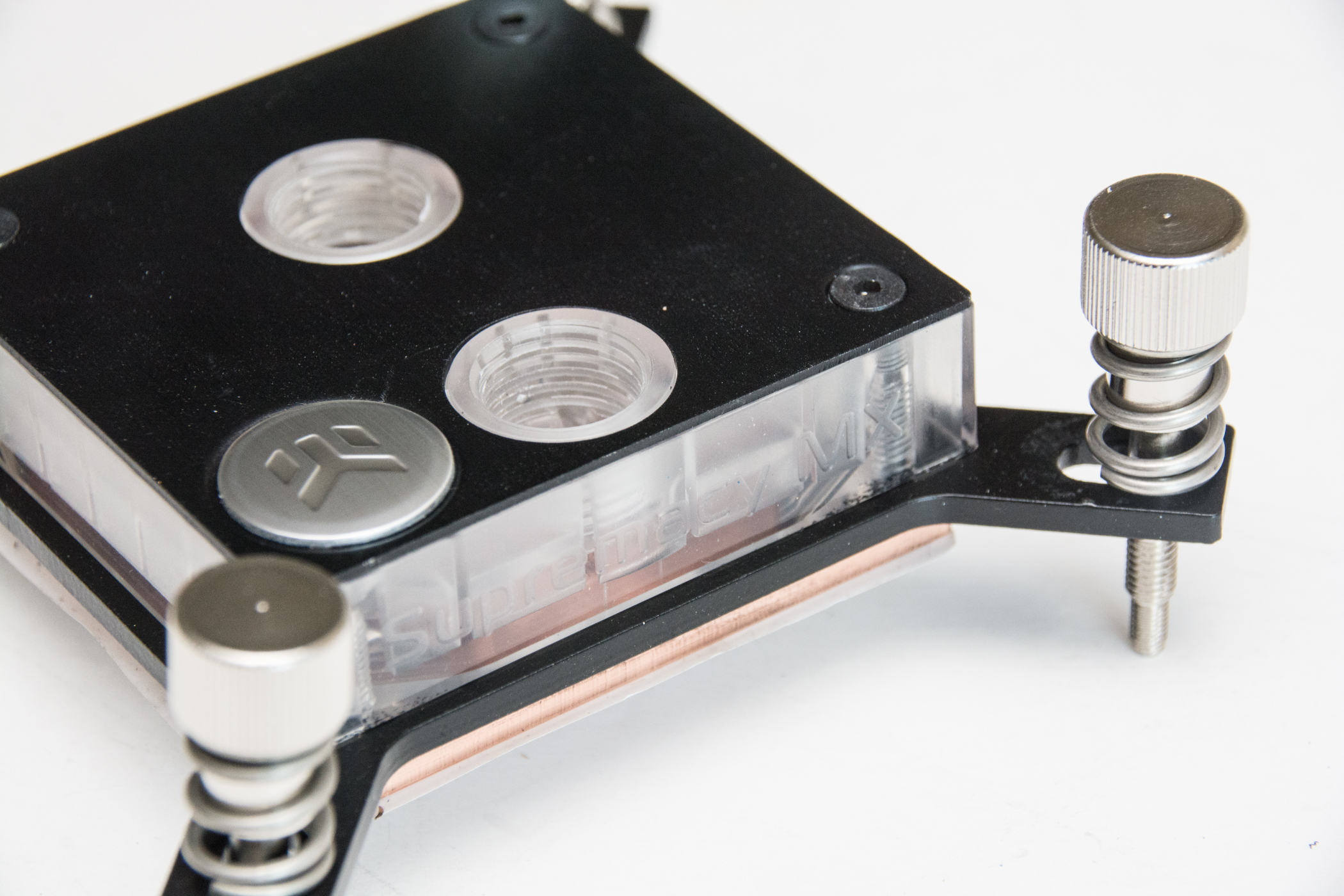
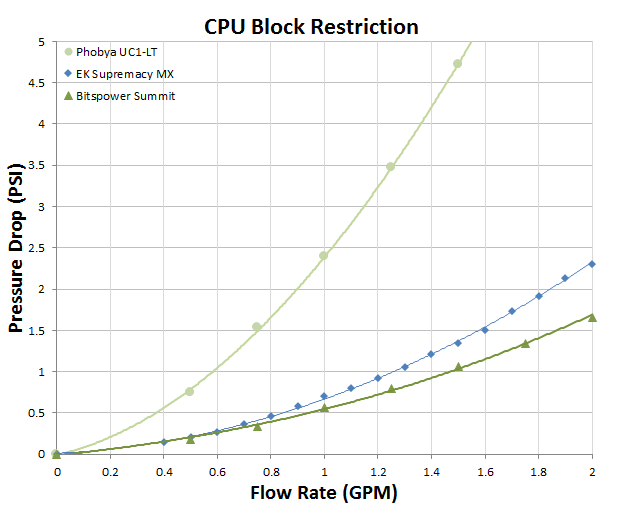
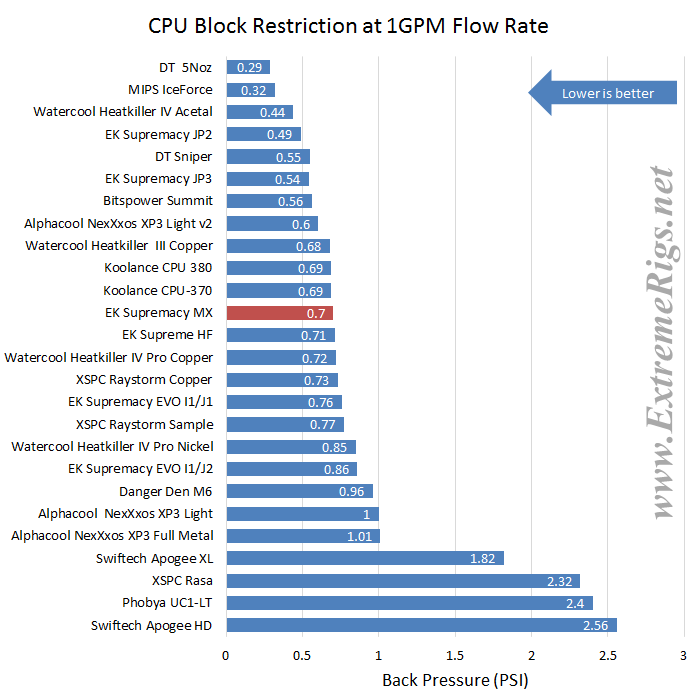

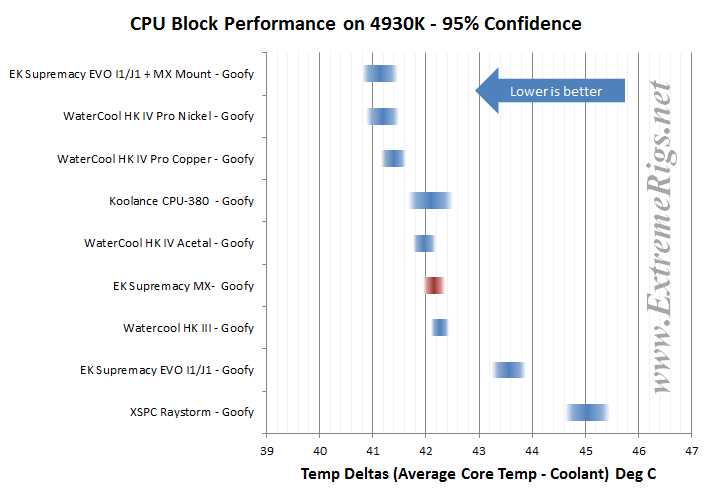
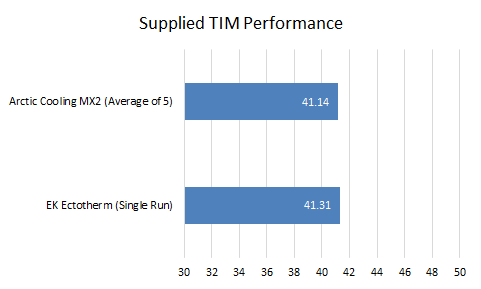



Another great review. Funny thing is I just purchased the Heatkiller IV Pro from PPC’s the day before you released this review. Almost made me consider getting two of these instead. They didn’t have any in stock anyway and in the end I like the look of the Heatkiller IV Pro better. I actually purchased two of the Heatkiller IV Pro (Acrylic top):
http://www.performance-pcs.com/heatkillerr-iv-pro-intel-processor-acryl-clean.html#!prettyPhoto
Although it’s not one of the ones that you reviewed, it’s still the same as the Black Acetal top one and will perform just as nicely. Thanks again for the detailed and amazing reviews that you do. You’re the reason why I just purchased:
2 x Coolgate CG-360G2 Rads
1 x Coolgate CG-240G2 Rad
2 x Heatkiller IV Pro (Acrylic Top) CPU Waterblocks
1 x Cablemod EVGA E-Series G2/P2 Cable Kit – Green
I’m preparing to hopefully do another Dual CPU Hachintosh build here very soon, and I’m just getting all the parts ready. On a side note you should consider doing what Jonny-Guru is doing for PSU reviews. That’s if you’re interested in doing this type of extra work as quite a bit of these companies are using your reviews and awards as standard now. That should encourage you guys to do more. Keep it up !!!
[…] of the summer was EK’s new predator AIO. Essentially EK took their Supremacy MX block which performed very well in our testing and added a modified version of their PE radiator with a low power DDC pump attached. EK’s […]
[…] despite not having a predator, we have reviewed a fair amount of the components here including the Supremacy MX, the EK Vardar and the EK PE radiator. So let’s combine that info as best we can to […]
Comments are closed.